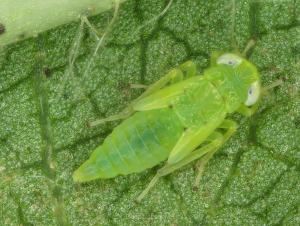It has been a long couple of months since the Cotton Jassid was first detected in Florida cotton during the first week of July. Within 4 weeks, it had spread to ~115 counties across Florida, Alabama, Georgia, and South Carolina. By the end of the season, the Cotton Jassid had been detected in every cotton-growing county in these states, as well as a couple of cases in Mississippi, Tennessee, Texas, and North Carolina. While we were unsure what the Cotton Jassid would mean for U.S. cotton, we quickly learned that this pest should absolutely not be overlooked.
–
Biology
The Cotton Jassid is native to the Indian Subcontinent, where it is a significant pest of cotton, okra, and eggplant. In the western hemisphere, it was first detected in Puerto Rico in 2023. In the late fall of 2024, it was detected for the first time in the United States through the Florida CAPS trapping network, confirmed in 16 counties, primarily in Southern Florida, with one county in the Panhandle, and 33 positive sites had active populations.

Figure 1. Adult two-spot Cotton Leafhopper with black dots on the wings. Photo: Isaac Esquivel, UF/IFAS
Adult Cotton Jassids are small (1-2mm), pale green insects with yellowish-green wings that look very similar to other small green leafhoppers, such as the potato leafhopper. Adults can be distinguished from most native species in North America by the pair of black spots on the head and black spots at the tip of each wing. There is no definitive way to distinguish early-stage nymphs, but later-stage nymphs can have 4 black dots on the wing pads (Figure 1). Like other leafhoppers, they feed on cell contents and are often found on the lower surface of leaves. In cotton, high populations can produce a ‘hopperburn’ effect characterized by yellowing, reddening, and browning of the leaves and, in extreme cases, defoliation.
While there is plenty of literature on the lifecycle of Cotton Jassids in their native range, much remains to be learned about how it will differ in the United States. Females lay eggs in leaf tissue, with a single female laying between 13 and 34 eggs in her lifetime. Eggs hatch in 3-4 days, and nymphs develop through 5 instars in 8-12 days. Adults live for 2-4 weeks, with new generations every ~2 weeks.
Cotton jassids are highly polyphagous (feed on many different plants) with over 25 reported reproducing hosts but they tend to prefer malvaceous and solanaceous crops such as cotton, okra, and eggplant. We have observed adult jassids in soybean, corn, and peanut. However, we have not observed reproduction in these crops, nor have we seen signs of plant injury, suggesting that adults may be using them for sustenance rather than reproduction. In terms of alternative non-crop hosts, we have observed reproducing Jassid populations on several hibiscus species —Swamp Rose Mallow, Turk’s Cap, and other ornamental hibiscus —and on Ceaser Weed.
–
Management and Scouting:
The main questions to answer with an emerging invasive pest species are: 1. How do we kill this insect? 2. Does it matter (does it limit yield)? 3. When do we kill this insect (thresholds)? Collaborative efforts by extension specialists at the University of Florida, Auburn University, Clemson University, and the University of Georgia have provided some preliminary answers to help prepare for the 2026 season.
Thanks to a combination of on-farm and experiment station trials, a solid list of Insecticide recommendations and efficacy data have been developed across the southeast. Our preliminary threshold (1 nymph per leaf) was developed from a trial at the NFREC-Quincy location. We started with a recommendation of 5 nymphs per leaf. As Jassid pressure began to build in the trial and the rapid progression of hopper burn symptoms, this quickly dropped to 3 per leaf, 2 per leaf, 1-2 per leaf, and finally 1 per leaf. Trials are planned to validate and further refine this threshold in 2026.
Jassids tend to build up along field borders and are often found first on isolated plants at the edge of the field, which can indicate that a particular field should be scouted more closely. To scout fields, target the mainstem leaves on nodes 3, 4, and 5 below the terminal. Carefully flip leaves over and note the presence of adults and nymphs (immature). Because populations can build and fields crash so quickly, grower logistics should also be incorporated into threshold considerations. For example, if sprayers can only get across fields every 10-14 days, applications may be needed if cotton jassids are found at threshold on 30-50% of the plants scouted.
There are still more questions than answers for 2026, and collaborative efforts across the Southeast are planned to better understand the pest dynamics of Cotton Jassid and its effects on cotton in the region. One thing we do know is that if you intend to plant cotton next year, you absolutely MUST SCOUT your fields weekly.
–
Further information on Jassids:
–
First Report of Two-Spot Cotton Leafhopper (Amrasca biguttula Ishida) (Hemiptera: Cicadellidae) on Commercial Cotton in the Southeastern United States
–

